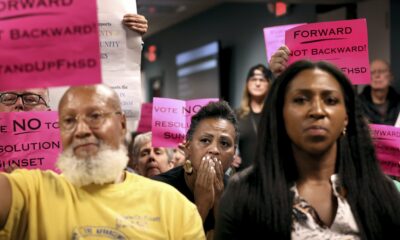Labor & Economy
The Fix: Restoring the Rights of Misclassified Workers

(This is the last in a three-part series about the misclassification of employees as independent contractors – a practice which affects millions of workers in the U.S., including most of the nation’s nearly 100,000 port truck drivers.)
An illegal practice as systemic and widespread as independent contractor misclassification suggests a collective failure of enforcement. Given the huge fiscal, human and environmental costs, what can be done to ameliorate this failure?
The problem is not that the practice is permitted under current law. On the contrary, the phenomenon is referred to as misclassification precisely because it involves the systematic violation of employee protection laws, justified by re-labeling employees as independent contractors.
Employers misclassify workers essentially because 20th century mechanisms of enforcement have not caught up with this spurious 21st century “business practice.” Lawsuits are expensive, time-consuming, risky and subject to a massive justice gap between industry and workers. Administrative enforcement of the laws is hampered by chronic under-staffing, by fines that often do not make a dent in a company’s decision calculus, and by the ubiquitous political attacks by special interests that undermine the ability of government to hold businesses accountable for the benefit of all citizens.
Moreover, the fact that an employee must prove misclassification separately under each statutory scheme (the National Labor Relations Act, the Fair Labor Standards Act, etc.) is a tremendous inefficiency of the current system, stalling effective enforcement.
Three types of change to the existing system are possible: 1) reforming the substantive law; 2) changing the remedies available to courts and agencies in dealing with violations of law; and 3) increasing the capacity of enforcement agencies to do what they are already doing. Short of such changes to the system, strategic action by both enforcement agencies and misclassified workers can make real inroads into the problem.
In an ideal world, we would simply do away with the detritus of unnecessary legal definitions, and institute a single definition of “employee” across all the applicable federal laws. (Individual states could undertake the same reform.) The effectiveness of this reform would be bolstered by creating a presumption in favor of employee status if certain, simple-to-check-for criteria are met. For example, the definition might state that all workers who work at least 20 hours a week for a single business, make less than 150 percent of the minimum wage and do so either indefinitely or for at least a two-month term are presumptively employees.
Other legal factors, which could defeat the presumption, would include whether the worker has a true opportunity for profit and loss; whether the work performed is integral to the regular business of the putative employer; the extent of the company’s control over the performance of the work; and the length of the period of service.
A more modest reform to our existing system would be to clarify and solidify the power courts and agencies have to remedy misclassification once it has been proven. Courts could be expressly authorized to issue injunctions ordering violating businesses to re-classify their workers as employees, so long as they continue to follow essentially the same business model. Agencies could be authorized to issue similar orders. Such orders are necessary to counteract the problem, given industry’s penchant for slightly changing a detail of a working arrangement in order to force the issue of misclassification to be re-litigated.
Finally, a straightforward but powerful measure would simply address capacity issues within regulatory agencies. This involves both increasing the number of investigators and attorneys in over-taxed enforcement agencies, and empowering agencies to do their jobs – to enforce the law – when special interests attack them for doing just that.
Short of any of the above reforms, however, there are effective ways that we can all begin to address the systematic misclassification of employees. Agencies can target particularly key bad-actor industries, such as port trucking, as they have started to do. Workers and advocates can challenge misclassification, and expose to the public harmful industry practices resulting from misclassification. Community members and groups can speak out about the ill effects that low-road employers, utilizing practices such as misclassification, have on their communities.
Lawyers can seek creative injunctions, pursue influential test cases in key industries and, most importantly, engage in strategic lawsuits in concert with coordinated worker and community coalitions in order to address the systemic problem.
Restoring the basic rights of the millions of misclassified U.S. workers and making sure we put the public interest first will not be easy. But the alternative is unthinkable for a society that aspires to fairness and to a sustainable future.
This is the third in a three-part series. See Part I: Forward into the Past? and Part II: Name Games: The Cost of Independent Contractor Misclassification.
-

 California UncoveredApril 9, 2024
California UncoveredApril 9, 2024700,000 Undocumented Californians Recently Became Eligible for Medi-Cal. Many May Be Afraid to Sign Up.
-

 Feet to the FireApril 22, 2024
Feet to the FireApril 22, 2024Regional U.S. Banks Sharply Expand Lending to Oil and Gas Projects
-

 Class WarMarch 26, 2024
Class WarMarch 26, 2024‘They Don’t Want to Teach Black History’
-

 Latest NewsApril 10, 2024
Latest NewsApril 10, 2024The Transatlantic Battle to Stop Methane Gas Exports From South Texas
-

 Latest NewsApril 23, 2024
Latest NewsApril 23, 2024A Whole-Person Approach to Combating Homelessness
-

 Latest NewsMarch 27, 2024
Latest NewsMarch 27, 2024Street Artists Say Graffiti on Abandoned L.A. High-Rises Is Disruptive, Divisive Art
-

 State of InequalityApril 11, 2024
State of InequalityApril 11, 2024Dispelling the Stereotypes About California’s Low-Wage Workers
-

 State of InequalityMarch 28, 2024
State of InequalityMarch 28, 2024Los Angeles Hotel Workers Could Use the 2028 Olympics to Their Advantage




















